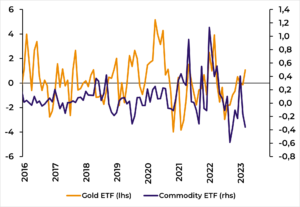The banking crisis led to a selloff in the commodity market
Grains, energy, and metals saw a withdrawal of a significant amount of speculative money, as risk aversion was heightened by the uncertainty on whether the banking crisis would be contained or not. The American Dollar and precious metals, on the contrary, saw net increases in their long positions as investors sought safe havens. Flows have also risen to gold ETFs, while commodities have lost their interest.
However, central banks were quick to rescue the system from these fragilities and injected liquidity into the market – which led, for example, to the first increase in the Fed’s balance sheet since 2020. Even though uncertainty remains elevated, commodity demand, particularly for metals and energy, has not been impacted by this macro setup. Nonetheless, the supply side may have been.
Uncertainty remaining elevated in the financial markets will keep investments low for some time, especially after the Fed decided to increase interest rates even during this economic turmoil. This means credit costs will continue going up, disincentivizing capex allocation. Not to mention that fear and risk aversion are likely to keep producers away from making investment plans, as they will focus on being solvent to protect themselves from a high-interest-rate environment – where economic growth is usually weak.
Therefore, the banking crisis had a clear financial impact on commodity prices, but demand has remained unchanged. Supply, which had already been troubled in the energy and metals space, could see further deterioration due to heightened credit costs and uncertainty in the short-term – leaving commodities with a constructive view going forward as soon as this macro environment is overcome.
Net Money Flow to Gold and Commodity (Million US$, US)

Source: Refinitiv







